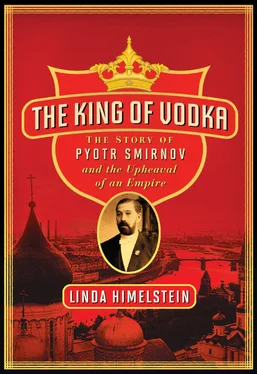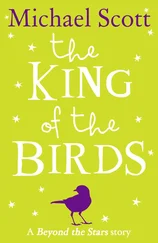The tsar acted quickly, imposing quarantines wherever cases were reported. Anyone wishing to leave sequestered communities had to endure observation periods that could last anywhere from eight days to two weeks. Those detained had to wash themselves daily with a chlorine-lime solution. 2Their luggage was repeatedly fumigated. Once outside the quarantined zone, travelers had to get through military-enforced cordons. Of the eighteen entrances leading to Moscow eight were shuttered, slowing trade and sharply restricting movement. Guards were ordered to shoot anyone who tried to break through the barriers. 3
Other cleansing measures were just as onerous. Walls and floors in the homes of the infected were sprinkled with chlorine. Clothes and sheets were either rigorously washed in chlorine or simply burned. All water was boiled and the eating of apples, prunes, melons, and cucumbers was forbidden. Garlic, a natural disinfectant, became part of people’s diets as the government doled out daily rations.
The tsar’s containment policies applied to everyone, regardless of social position or stature. In September 1830, the poet Aleksander Pushkin had planned a short trip to his family’s estate in Boldino. He ended up staying there, under virtual house arrest, for three months. This period, nonetheless, turned out to be one of the most prolific in the writer’s life. Among other works, he came close to completing his most famous, Eugene Onegin , while under quarantine. 4
But most others were not as fortunate. Mass hysteria overtook many who spread ugly rumors that cholera was the weapon chosen by Jews, foreigners, government officials, and aristocrats to rid the nation of its niggling underclass. People charged that wells were deliberately poisoned. 5The absurd talk inflamed the already suspicious masses. They were fed up with a string of seemingly endless regulations and began to speak of being heard, of fighting back, of murder. The talk soon escalated into violence.
In November 1830 the first cholera riot exploded in Tambov, three hundred miles southeast of Moscow. Mobs raided hospitals and police departments; they captured Tambov’s governor and killed doctors and officers suspected of mistreating or torturing patients. Rebels overtook the streets and broke into quarantined homes, liberating those who they said had been confined too long. The rebellion, finally suppressed by the Russian military after two violent days, caused serious damage. Some two hundred people in Tambov lost their lives and countless others suffered injuries.
Other riots sprouted throughout Russia, with one of the most serious erupting in St. Petersburg seven months after Tambov. Nearly six hundred people died every day as the situation disintegrated in the nation’s capital. Arrests were common during the first ten days of the epidemic. Typically humdrum behaviors, from eating vegetables to drinking water from canals, became criminal acts. Everyone was under suspicion and frustration gave way to anger. Citizens assembled near the cholera hospital in Sennaya Square, ambushing ambulances carrying infected residents. They threw stones at hospitals, smashing windows, then rushed the hospital itself, beating doctors and attendants who stood in the way. One doctor, a German, was discovered while treating a patient. Within moments, his body was left pummeled to death on the floor. The army fought furiously to subdue the angry crowds and restore peace. But it could not soothe their troubled souls. 6
That task was left to the tsar, who came out of seclusion at his summer palace in Peterhof to address his subjects. His personal appearance and arrival at Sennaya Square in an open carriage, with no military escort, was highly unusual. Tsars typically limited their interactions with their subjects, believing too much direct contact could undermine their prestige and authority. But this time, Nikolay I determined that the dire circumstances demanded his personal touch.
More than five thousand people gathered around the tsar, who rose in his carriage and crossed himself after seeing the destruction around him. He wore his military best, a crisp black double-breasted coat with gold buttons, which fit tightly around the tsar’s slim waistline before dropping loosely to just below his knees. Bright golden epaulettes surrounded by gold tassels adorned his shoulders, providing Nikolay I with the regal, authoritarian look this moment demanded.
The tsar stood, then commanded his people to kneel. “A great burden has been given us by God: a plague. We must take measures to stop its progress. All these measures have been taken by my orders. Therefore it is against me that you complain—Me! And I order obedience!…If you have offended me by your disobedience, you have offended God still more by a crime: A murder has been committed! Innocent blood has been spilled. Pray God that he forgive you.” 7
By the time cholera ran its course, Russia lost more than 243,000 of its citizens. 8It had also gained one infant boy, born in the midst of the epidemic and its mayhem.
PYOTR ARSENIEVICH SMIRNOV began life on Friday, January 9, 1831, at his home in Kayurovo, a village just sixty miles east of a quarantined district. The day was cloudy, dark, and cold. The home, known in Russian as an izba , like most others occupied by peasants in the area, was thoroughly modest. It was made of round pine logs, which sometimes had to be dragged for miles, and it had a slanted roof. The few windows were small, the distance between the end of a person’s fingertips and elbow. Each was covered with the dried bladder of a bull, which did not do nearly enough to keep out the cold but was useful in letting in some natural light. The typical structure, at just 420 square feet, offered little privacy for the multiple generations who routinely lived together. [3] Details of Smirnov’s village life are drawn from regional museums and archives with the help of Vladimir Grechukhin. They reflect the most pervasive local customs at the time.
Delivering babies in a small village like Kayurovo was treated like any other task on the farm. Pyotr’s mother, Matryona, was likely placed on a plank bed near the oven in the middle of the room. The huge oven was the focal point of peasant home life. In those days, the oven had a large hole so people could climb inside, sit down, and wash themselves in relative warmth and comfort. Elder family members slept on a flat surface on top of the oven. The oven was also where most of the cooking took place, and where young calves, lambs, and pigs were kept to protect them from the harsh conditions outdoors. The heavy odor here, as if fused into the walls and floors, was a peculiar mixture of boiled potatoes, meats, soups, and animal fur. That day, however, only the laboring mother and a local midwife occupied the coveted spot.
Few details of Smirnov’s birth are known. The simple four-line birth record, typical for serfs, listed first the name of the landowner for whom the family worked. It then listed the village name, the father’s name, the godfather’s name, and the baby’s gender. Last came the child’s given name: Pyotr. 9No surname was provided as most serfs did not have one. It was unnecessary, primarily because serfs rarely traveled outside their small communities. Exactly when Pyotr did gain a surname is not clear, though most likely it was more than two decades later. Smirnov was a common last name in the region and a derivative of smirnoy , meaning quiet and law abiding. Today, 2.7 million Russians call themselves Smirnov, making it the most common name in the nation. 10
It can be assumed that Pyotr was born hearty. The infant mortality rate in Russia was among the highest in nineteenth-century Europe. Indeed, one out of every four babies born died before they reached their first year of life. The Smirnovs themselves lost three infant girls of their own, two from epilepsy and one from measles. 11But Pyotr, the third out of four surviving children and the second son, was a standout from the start.
Читать дальше












